
Theobroma cacao, also called the cacao tree and the cocoa tree, is a small evergreen tree in the family Malvaceae,. Its seeds, cocoa beans, are used to make chocolate liquor, cocoa solids, cocoa butter and chocolate. The largest producer of cocoa beans in 2018 was Ivory Coast, with 37% of the world total.

The Pentatomoidea are a superfamily of insects in the Heteroptera suborder of the Hemiptera order. As Hemiptera, they share a common arrangement of sucking mouthparts. The roughly 7000 species under Pentatomoidea are divided into 21 families. Among these are the shield bugs, giant shield bugs, burrower bugs, and stink bugs.

Pentatomidae is a family of insects belonging to the order Hemiptera, generally called shield bugs or stink bugs. Pentatomidae is the largest family in the superfamily Pentatomoidea, and contains around 900 genera and over 4700 species. As hemipterans, the pentatomids have piercing sucking mouthparts, and most are phytophagous, including several species which are severe pests on agricultural crops. However, some species, particularly in the subfamily Asopinae, are predatory and may be considered beneficial.

Anasa tristis is a species of bug in the family Coreidae. It is a major pest of squash and pumpkins, found throughout North America, and is a vector of the cucurbit yellow vine disease bacterium. These bugs can emit an unpleasant odor when disturbed. It is commonly known as the squash bug but shares this name with certain other species.

Scutelleridae is a family of true bugs. They are commonly known as jewel bugs or metallic shield bugs due to their often brilliant coloration. They are also known as shield-backed bugs due to the enlargement of the thoracic scutellum into a continuous shield over the abdomen and wings. This latter characteristic distinguishes them from most other families within Heteroptera, and may lead to misidentification as a beetle rather than a bug. These insects feed on plant juices from a variety of different species, including some commercial crops. Closely related to stink bugs, they may also produce an offensive odour when disturbed. There are around 450 species worldwide.
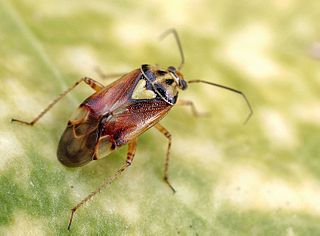
The genus Lygus includes over 40 species of plant-feeding insects in the family Miridae. The term lygus bug is used for any member of genus Lygus.
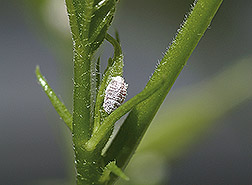
Maconellicoccus hirsutus, is a pest of many plants, trees, and shrubs. It infests hibiscus, citrus, coffee, sugar cane, annonas, plums, guava, mango, okra, sorrel, teak, mora, pigeon pea, peanut, grapevine, maize, asparagus, chrysanthemum, beans, cotton, soybean, cocoa, and many other plants. The pest forms colonies on the host plant, and if left undisturbed, the colonies will grow into large masses of white waxy coverings on branches, fruiting structures, leaves, and even whole plants, including large trees.
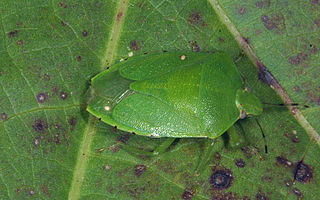
The green stink bug or green soldier bug is a stink bug of the family Pentatomidae.

Adelphocoris lineolatus, is commonly known as the Lucerne bug or the alfalfa plant bug, and belongs to the family Miridae. It is an agricultural pest causing vast amounts of damage to numerous crops, but primarily to alfalfa crops around the globe.
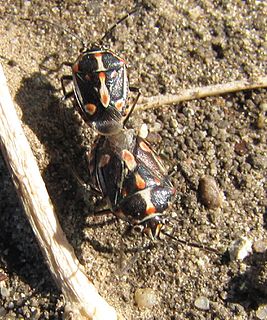
Bagrada hilaris is a species of shield bug known by the common names bagrada bug and painted bug (See a short video at YouTube). It could be mistaken for or erroneously referred to as harlequin bug. It is native to Africa. It is known elsewhere as an introduced species, including California and Arizona, where it was first reported in 2008. It is a major pest insect of Brassica oleracea crops, and related crucifers such as turnips, rape, and mustard. The adult and nymph of the species suck sap from the leaves of the plants, causing wilting, yellowing, and stunting of growth. Besides crucifers, the bugs are known on papaya, sorghum, maize, potato, cotton, caper, pearl millet, and some legumes. Large numbers of the bug congregate on the plants and cause extensive damage.

Tessaratomidae is a family of true bugs. It contains about 240 species of large bugs divided into 3 subfamilies and 56 genera.
The environmental impact of cocoa consumers includes deforestation, soil contamination, and herbicide resistance. The majority of cocoa farms are now located in Côte d'Ivoire and Ghana.

Aphis craccivora, variously known as the cowpea aphid, groundnut aphid or black legume aphid, is a true bug in the family Aphididae. Originally of probable Palearctic origin, it is now an invasive species of cosmopolitan distribution.

Euthyrhynchus floridanus, the Florida predatory stink bug, is a species of carnivorous shield bug in the family Pentatomidae, the only species in the genus Euthyrhynchus. It is native to the hottest parts of the southeastern United States and is considered beneficial because it feeds on many species of pest insects. They also feed on things such as grasshoppers and other small insects. This species also hunts in a pack, with up to twelve.
Pseudotheraptus wayi, the coconut bug, is a species of leaf-footed bug in the family Coreidae. It is a pest of coconut in East Africa.
Deraeocoris brevis is a species of predatory plant bug in the family Miridae. It is native to North America where it feeds on plant pests in apple and pear orchards.

Hypomeces squamosus, also known as the gold-dust weevil or green weevil, is a species of beetle in the true weevil family. The adult weevil can reach a length of about 14 mm (0.6 in) and is covered with iridescent green or yellowish-green dust-like scales all over the body. This species can be found in India, tropical Southeast Asia, and the Philippines. Both the larvae and adults are crop pests. The larvae live in and pupate in the soil, feeding on living plant roots. The adult weevils are long-lived, doing damage to foliage, and sometimes defoliating young bushes and nursery trees.

Leptoglossus gonagra, known as the passionvine bug, citron bug or squash bug in different parts of its range, is a species of leaf-footed bug in the family Coreidae. It is found in Africa, the Caribbean, Central America, North America, South America, Southern Asia, the Pacific Ocean and Oceania.
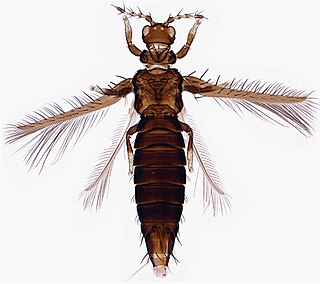
Selenothrips rubrocinctus, commonly known as the redbanded thrips, is a species of thrips in the family Thripidae. It was first described from the West Indies but may have originated in northern South America. It has spread to other parts of the world and now has a near pan-tropical distribution, occurring in North, Central, and South America, Africa, southern Asia, and Australasia.
Bathycoelia is a genus of shield bugs in the subfamily Pentatominae and tribe Bathycoeliini.















